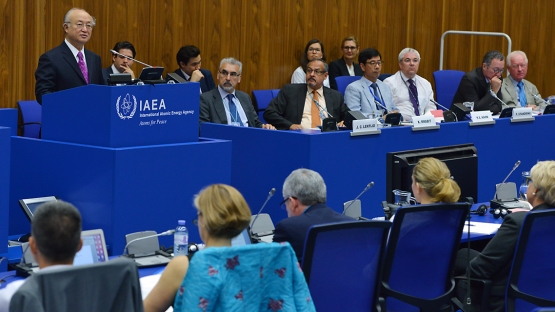There have been important developments in the management of radioactive waste in recent years, but the wider public is often unaware of them, said IAEA Director General Yukiya Amano at the opening of an international conference on spent fuel management today in Vienna, Austria. Read or watch the full statement.
Significant progress has been made in the development of deep geological disposal facilities for high-level radioactive waste and spent fuel, especially in France, Finland and Sweden, he said. Facilities to store low- and intermediate-level waste have long been in operation around the world.
“It will still be some years before the first deep geological repositories for nuclear spent fuel become operational, “Mr Amano said. “But the progress being made in this area deserves to be better known.”
The projected growth in global use of nuclear power in the coming decades will lead to an accompanying increase in the volume of spent fuel that needs to be managed safely. The Director General noted that an IAEA safety guide on the storage of spent nuclear fuel, published in 2012, was being revised to take into account the lessons learned from the Fukushima Daiichi accident.
Spent fuel is steadily accumulating in short- and medium-term storage as countries consider long-term disposal and recyling options. Some 250 participants from 41 countries at the five-day International Conference on Management of Spent Fuel from Nuclear Power Reactors: An Integrated Approach to the Back End of the Fuel Cycle will share the latest information on how government bodies, operators, spent fuel service providers and waste agencies are addressing these issues. Particular attention will be given to the safe management of spent fuel and the progress being made to develop the first high-level disposal facilities for power reactor fuels.
“Since your last conference, the IAEA has launched a programme to demonstrate the long-term performance of dry stored spent fuel and related storage system components,” Mr Amano said. “We are also finalising a new guidance document on the use of dual-purpose casks for both transport and storage.
He highlighted the vital importance of having cradle to grave plans in place for both spent fuel and radioactive waste, especially for countries just embarking on a nuclear power programme, also referred to as ‘newcomers’.
“I strongly encourage countries with existing nuclear power programmes, and experience of the back end of the fuel cycle, to share their experience with newcomer countries to ensure that best practice is implemented everywhere,” he said.
A holistic view of the fuel cycle
The IAEA hosts an International Conference on Management of Spent Fuel from Nuclear Power Reactors every three to five years. Participants include representatives of governments, regulatory bodies, industry, and spent fuel and waste management organizations.







